In a memorable visit to Rome, Mark Nicholls reflects on the absorbing atmosphere and ambience of the streets around Piazza Navona and beyond…
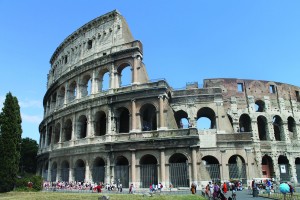 The cobbles of Ponte Sant’Angelo are weathered and well-worn by the steady footfall of millions of pilgrims over the centuries. Lined by a double row of angels and in the shadow of the imposing Castel Sant’Angelo, the bridge across the river Tiber was, and still is, the historic link between St Peter’s Basilica and the heart of Rome. Like so many in the past, it was a route I gladly followed from my hotel close to the Vatican City as I was drawn into the labyrinth
The cobbles of Ponte Sant’Angelo are weathered and well-worn by the steady footfall of millions of pilgrims over the centuries. Lined by a double row of angels and in the shadow of the imposing Castel Sant’Angelo, the bridge across the river Tiber was, and still is, the historic link between St Peter’s Basilica and the heart of Rome. Like so many in the past, it was a route I gladly followed from my hotel close to the Vatican City as I was drawn into the labyrinth
of shaded streets toward Piazza Navona, perhaps the most famous square in
the city for sipping coffee, dining al fresco, and people-watching.
It has a natural buzz. The area is alive with artists, street entertainers, musicians and vendors who mingle with visitors from across the globe against the backdrop of Bernini’s marble Fountain of the Four Rivers and the Baroque façade of the Church of Sant’Agnese in Agone. But in so many ways, it is the journey to Piazza Navona that is equal to the destination – via a complex network of small piazzas, linked by narrow, meandering streets lined with houses and apartments, shops, bars and restaurants.
A CITY TO CELEBRATE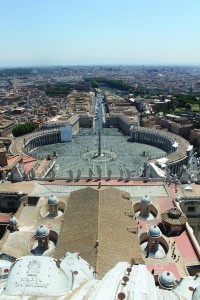
Over a long weekend in Rome – with friends to celebrate landmark birthdays in style – I spent hours wandering these streets, sitting in bars sipping the chilled Frascati of the Lazio region, enjoying gelati and dining on fine Roman cuisine. This was an area I never tired of. It was one that was constantly changing as it was brought to life throughout day and night by a different combination of musicians, artists or simply the subtle variations
found on restaurant menus. The inhabitants of these small corners and niches were all performers in their own unique way: street musicians and buskers playing the soundtrack to central Rome; artists painting mini-masterpieces as memories for visitors to take home or scratching charcoal caricatures of tourists; street vendors selling bags, Italia shirts, caps and the trinkets and souvenirs of the Eternal City; or chefs conjuring the tastes, flavours and the inimitable aroma of cucina romana.
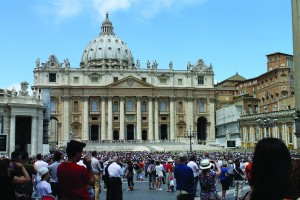 TASTING ITALY
TASTING ITALY
They all have a different story to tell. On the bridge over the Tiber, the aptly-named Sandro Fiume sits on his stool with his guitar – a regular performer over the past two years on the route from Ponte Sant’Angelo to Piazza Navona – playing blues and rock to passers-by.
“The music adds so much to the atmosphere of this part of the city,” he says. And he is right, whether it is the rhythmic twang of a blues guitar or the deep tones of a cello.
Once over the bridge and into the area of cobbled streets cupped by the bend in the Tiber, small restaurants are open for business with diners sitting at tables adorned with red and white check tablecloths. The Osteria del Pegno, on Vicolo di Montevecchio, is one popular choice. This area was once frequented by artists Michelangelo, Da Vinci and Raphael. They lived here centuries ago while they worked on St Peter’s Basilica and the Vatican.
Once a pawn shop – suggested by the name pegno which means a pledge or token – it has been lovingly converted into a superb restaurant by Massimo Natale. Here, he attempts to bring together the traditional flavours of Rome with those of the Abruzzo region, where he comes from some 50 miles (80km) to the east. This is served to appreciative and loyal diners with a large menu, featuring dishes such as fettuccine with porcini mushrooms or potato gnocchi with clams.
THE ARTISTIC SOUL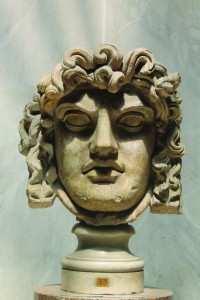
Massimo explains: “We have only enough places for 40 people because that is the number that I believe we can serve well and continue to maintain the quality of the food and the pleasant dining experience. People want to eat in a place that has a lovely atmosphere and we feel this is the perfect size for that. For me, what is also important is that everything is home-made and that
we use seasonal produce.”
On the Via Della Pace there are more restaurants and fashionable bars where Romans and tourists mingle in the summer sunshine.
A little further along, the narrow alley opens out into the magnificence of Piazza Navona. Hemmed in by grand buildings, the square traces the shape of the long-lost Stadium of Domitian and is lined with fascinating cafés and bars.
Nearby, I meet street artist Walid Cheikh, who is originally from Syria but has been living in Rome for 30 years. An architect by profession, he now sells his watercolour and acrylic paintings of typical Rome scenes in the piazza. While there are brushes with the regulatory authorities, Walid is convinced the artists add to the atmosphere of the area.
“Our presence helps the square to live,” he tells me. “If you imagine the square without artists, it has much less life to it. We are important for an historical square like Piazza Navona, which is so special.
The square is the natural conclusion to a journey through the narrow streets around it – part of that experience, which adds enjoyment to the visitor, is the restaurants, the musicians, artists and performers along the way.”
Away from the square, there is so much to see and do in Rome. The Pantheon is unmissable, the splendour of the church of St Ignazio Loyola is an unexpected surprise and the Trevi Fountain is a must see. Don’t forget that all visitors should follow the legend of throwing coins over their shoulder into the fountain to ensure a return to Rome. Further on are the Spanish Steps, which bring you close to the city’s shopping area.
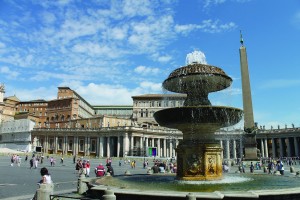 Of course, no visit to the Italian capital would be complete without absorbing the important religious sites and those of ancient Rome. Staying at the Atlante Star Hotel – in a side street close to the Vatican City – meant St Peter’s Basilica was only a few minutes away. Stunning beyond belief, a climb to the Dome offers an amazing panoramic view of the colonnaded square and the Vatican Gardens, while the wondrous artefacts and artwork of the Vatican Museum and the Sistine Chapel are mesmerising.
Of course, no visit to the Italian capital would be complete without absorbing the important religious sites and those of ancient Rome. Staying at the Atlante Star Hotel – in a side street close to the Vatican City – meant St Peter’s Basilica was only a few minutes away. Stunning beyond belief, a climb to the Dome offers an amazing panoramic view of the colonnaded square and the Vatican Gardens, while the wondrous artefacts and artwork of the Vatican Museum and the Sistine Chapel are mesmerising.
If you are nearby on a Sunday, wait in St Peter’s Square for Pope Benedict XVI’s traditional papal blessing at noon on the masses gathered below the windows of his Vatican apartment.
For my main sightseeing, the new three-day OMNIA pass (€85), which offered fast-track admission to The Vatican, Sistine Chapel and St Peter’s Basilica plus top-deck bus-ride views of the city and audio commentary, helped me get the most out of my stay. It’s certainly worth investing in as soon as you arrive.
RETURNING TO ROME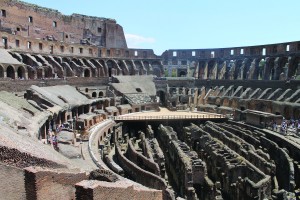
The pass covered many other attractions including the Colosseum, Roman Forum and Palatine Hill, all reminders of the power that
the Roman Empire once wielded. I took the time, also, to appreciate the symmetry of the Piazza del Popolo and the monumental solidity of the Vittorio Emanuele Monument in Piazza Venezia with its wonderful views across the city.
The combination of wandering the narrow streets on foot and using the OMNIA pass enabled me to enjoy the major attractions, while also revelling in the ambience of Rome: a city to relax, see the sights and to eat, drink and celebrate in.
And the small coin thrown over the shoulder at the Trevi Fountain suggests I am sure to be back in the Eternal City before too long.
We’ve put together some top tips from where to stay to what to see and do to get the most pout of your trip to Rome. Click here to start planning!
